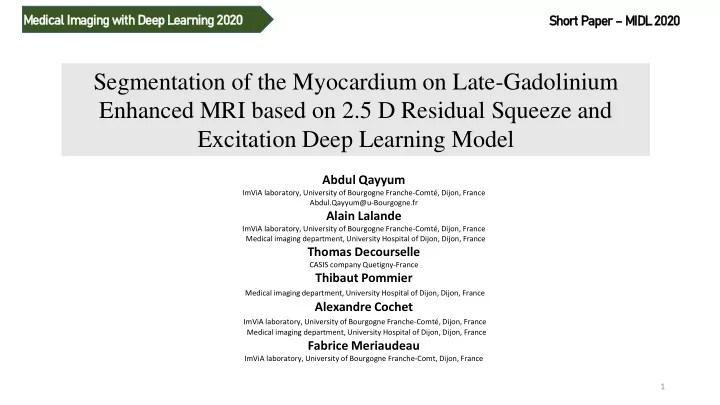

Medi dical cal Imagin ging g with th Deep ep Learni ning ng 2020 20 Short t Paper er – MID IDL L 2020 20 Segmentation of the Myocardium on Late-Gadolinium Enhanced MRI based on 2.5 D Residual Squeeze and Excitation Deep Learning Model Abdul Qayyum ImViA laboratory, University of Bourgogne Franche-Comté, Dijon, France Abdul.Qayyum@u-Bourgogne.fr Alain Lalande ImViA laboratory, University of Bourgogne Franche-Comté, Dijon, France Medical imaging department, University Hospital of Dijon, Dijon, France Thomas Decourselle CASIS company Quetigny-France Thibaut Pommier Medical imaging department, University Hospital of Dijon, Dijon, France Alexandre Cochet ImViA laboratory, University of Bourgogne Franche-Comté, Dijon, France Medical imaging department, University Hospital of Dijon, Dijon, France Fabrice Meriaudeau ImViA laboratory, University of Bourgogne Franche-Comt, Dijon, France 1
Medi dical cal Imagin ging g with th Deep ep Learni ning ng 2020 20 Short t Paper er – MID IDL L 2020 20 Introduction & Overview Myocardium and Myocardial Infarction ▪ Myocardial infarction (MI) is an important cause of death worldwide. ▪ Late gadolinium enhancement (LGE) MRI is highest Introduction resolution technique to assess the myocardium and myocardial infarction. ▪ Brightness heterogeneities due to the non- homogeneous ▪ Partial volume effects Challenges ▪ Inherent noise due to motion artefacts and heart dynamics ▪ The presence of banding artefact • This work aims to develop an accurate automatic Myocardium and myocardial infarction Solution segmentation method based on deep learning models for the myocardial borders on LGE-MRI and evaluation of the extend of the MI need the knowledge of the myocardial borders 2
Medi dical cal Imagin ging g with th Deep ep Learni ning ng 2020 20 Short t Paper er – MID IDL L 2020 20 Data Acquisition & Processing Total (348 Cases) 1 Testing (cases 28) 320 cases(1980) Intra and inter observer study 3 QIR(Quantified Imaging Resource) developed by CASIS (CArdiac Simulation and Imaging Software) company Training (256 cases) Validation (64 cases) 2 ▪ QIR software used for manual contouring of the myocardial borders (endocardium and epicardium) ▪ Moreover, intra-observer and inter-observer annotations were provided for the 28 test cases. LGE MRI (Left ventricle image Sequences) 3
Medi dical cal Imagin ging g with th Deep ep Learni ning ng 2020 20 Short t Paper er – MID IDL L 2020 20 2.5D Proposed Segmentation Model Special Convolutional Layer Residual and SE encoder blocks Stack of consecutive slices Training model with different set of hyperparameters Ensemble of Proposed Model Residual network with special layers and excitation block and ensemble the outputs of model 4
Medi dical cal Imagin ging g with th Deep ep Learni ning ng 2020 20 Short t Paper er – MID IDL L 2020 20 Experimental Results and conclusion Performance evaluation for proposed deep learning model. r represented correlation coefficient and BA is the bland altman Algorithms DSC (%) HD (mm) 𝒔 BA Bias (cm2) Intra-observer Base 86.66 3.01 0.976 0.10(0.50) variation Middle 85.24 2.94 0.961 -0.025(0.33) Apex 77.51 2.98 0.941 0.30(1.38) Overall 83.22 3.26 0.957 0.11 (0.85) Inter-observer Base 82.54 4.03 0.957 0.34(0.92) variation Middle 81.22 3.87 0.955 0.18(0.73) Apex 74.12 3.87 0.924 0.53(1.95) Overall 79.25 4.12 0.945 0.33 (1.31) Our Method Base 86.55 3.13 0.969 -0.16(0.57) Middle 84.77 3.65 0.955 0.30(0.87) Apex 76.85 3.69 0.930 0.31(1.56) Segmentation map for proposed and existing deep learning models for base, middle, and apex slices for single patient Overall 82.01 3.67 0.959 0.19 (1.07) Conclusion ▪ We have proposed a novel, fully automated ensemble model with 2.5 D strategy for myocardium border segmentation from LGE-MRI images. ▪ The proposed ensemble method shows excellent results as compared to existing state-of-the art deep learning models and lies with the intra- and inter- observer variabilities. 5
Recommend
More recommend